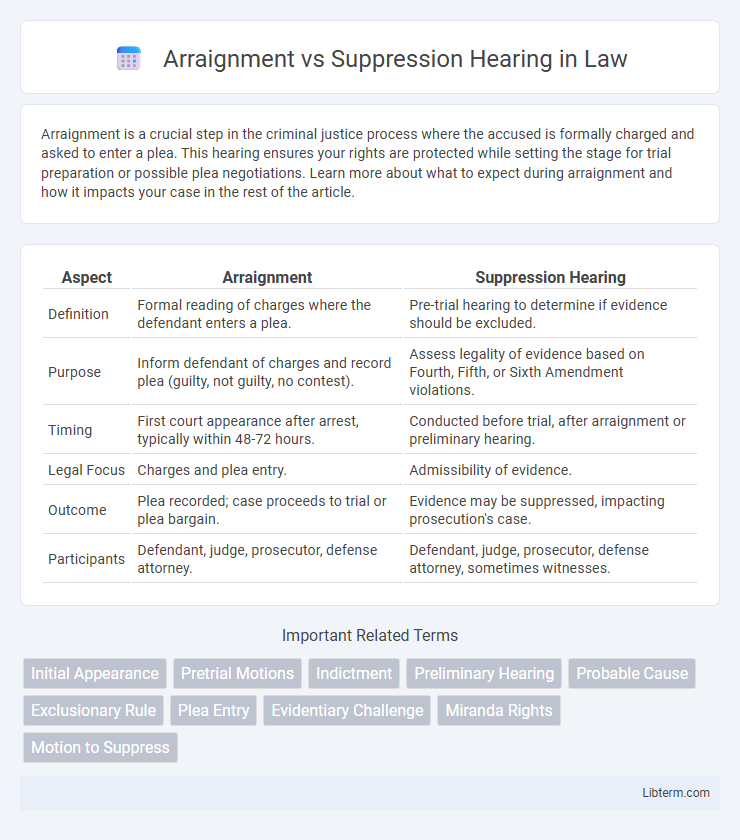Arraignment is a crucial step in the criminal justice process where the accused is formally charged and asked to enter a plea. This hearing ensures your rights are protected while setting the stage for trial preparation or possible plea negotiations. Learn more about what to expect during arraignment and how it impacts your case in the rest of the article.
Table of Comparison
| Aspect | Arraignment | Suppression Hearing |
|---|---|---|
| Definition | Formal reading of charges where the defendant enters a plea. | Pre-trial hearing to determine if evidence should be excluded. |
| Purpose | Inform defendant of charges and record plea (guilty, not guilty, no contest). | Assess legality of evidence based on Fourth, Fifth, or Sixth Amendment violations. |
| Timing | First court appearance after arrest, typically within 48-72 hours. | Conducted before trial, after arraignment or preliminary hearing. |
| Legal Focus | Charges and plea entry. | Admissibility of evidence. |
| Outcome | Plea recorded; case proceeds to trial or plea bargain. | Evidence may be suppressed, impacting prosecution's case. |
| Participants | Defendant, judge, prosecutor, defense attorney. | Defendant, judge, prosecutor, defense attorney, sometimes witnesses. |
Understanding Arraignment: The First Court Appearance
Arraignment marks the defendant's initial court appearance where charges are formally read, and a plea is entered, establishing the foundation for subsequent legal proceedings. This step is crucial for ensuring the defendant understands the accusations and their rights, including the right to counsel and to contest the charges. Unlike a suppression hearing, which focuses on evaluating the admissibility of evidence, arraignment centers on the procedural start, setting the case's trajectory.
What Happens During a Suppression Hearing?
During a suppression hearing, the court examines the admissibility of evidence, focusing on whether it was obtained legally or in violation of the defendant's constitutional rights, such as illegal search and seizure. Lawyers present arguments, including motions to suppress evidence that might have been gathered without proper warrants or probable cause. The judge then decides if the contested evidence will be excluded from the trial to ensure a fair legal process.
Key Differences Between Arraignment and Suppression Hearing
An arraignment is a court proceeding where the defendant is formally charged and enters a plea, establishing the initial stage of criminal litigation. A suppression hearing is a pre-trial motion focused on determining the admissibility of evidence, specifically whether evidence obtained unlawfully should be excluded. The key difference lies in the arraignment's role to address charges and plea, while the suppression hearing centers on evidentiary issues impacting the trial's fairness.
Legal Rights at Arraignment
During arraignment, the defendant is formally informed of the charges and advised of their legal rights, including the right to remain silent and the right to legal counsel. This hearing ensures the defendant understands the nature of the accusations and can enter a plea, such as guilty, not guilty, or no contest. Unlike suppression hearings, which focus on excluding improperly obtained evidence, arraignments prioritize safeguarding the defendant's due process rights at the outset of criminal proceedings.
Suppression Hearing: Challenging Evidence
Suppression hearings focus on challenging the admissibility of evidence, often arguing that the evidence was obtained in violation of constitutional rights, such as unlawful searches or coerced confessions. Effective suppression motions can prevent illegally obtained evidence from being presented at trial, significantly impacting the prosecution's case. Courts evaluate the legality of evidence collection methods to determine if suppression is warranted, ensuring defendants receive a fair trial under the Fourth and Fifth Amendments.
Timing: When Do Arraignment and Suppression Hearings Occur?
Arraignment typically occurs shortly after arrest, often within 48 to 72 hours, where the defendant is formally charged and enters a plea. Suppression hearings generally take place before trial, after arraignment, to determine whether evidence obtained unlawfully should be excluded from court proceedings. The timing of suppression hearings depends on the court schedule but must precede the trial to impact evidence admissibility.
Outcomes: Possible Results of Each Hearing
Arraignment outcomes typically include entering a plea of guilty, not guilty, or no contest, setting bail or release conditions, and scheduling future court dates. Suppression hearing results can lead to evidence being excluded if it was obtained unlawfully, which may result in case dismissal or reduced charges depending on the remaining evidence. The suppression hearing directly impacts trial strategy by determining what evidence the prosecution can use against the defendant.
Importance of Legal Counsel in Both Hearings
Legal counsel plays a crucial role in both arraignment and suppression hearings by ensuring the defendant's rights are protected and that appropriate legal strategies are employed. During arraignment, attorneys help clarify charges, advise on plea decisions, and negotiate bail conditions, while in suppression hearings, they challenge illegally obtained evidence to prevent it from being used against the defendant. Effective legal representation in these proceedings significantly impacts the outcome of the case, influencing trial conditions and potential sentencing.
How Arraignment Influences Subsequent Legal Proceedings
Arraignment is the initial court proceeding where the defendant is formally charged and enters a plea, setting the course for all subsequent legal actions. The plea entered during arraignment--guilty, not guilty, or no contest--directly impacts case strategy, influencing trial scheduling, pretrial motions, and potential plea negotiations. Properly conducted arraignments ensure defendants understand their rights and charges, which shapes the defense approach and can affect the likelihood and timing of motions such as suppression hearings.
Arraignment and Suppression Hearing: Impact on the Case
Arraignment is the defendant's initial court appearance where charges are formally read, and pleas are entered, setting the course for the case's progression and legal strategy. Suppression hearings assess the admissibility of evidence, often focusing on constitutional violations like illegal searches, which can significantly weaken the prosecution's case if evidence is excluded. The outcomes of arraignments and suppression hearings collectively shape the defendant's trial options and potential case resolution.
Arraignment Infographic

 libterm.com
libterm.com